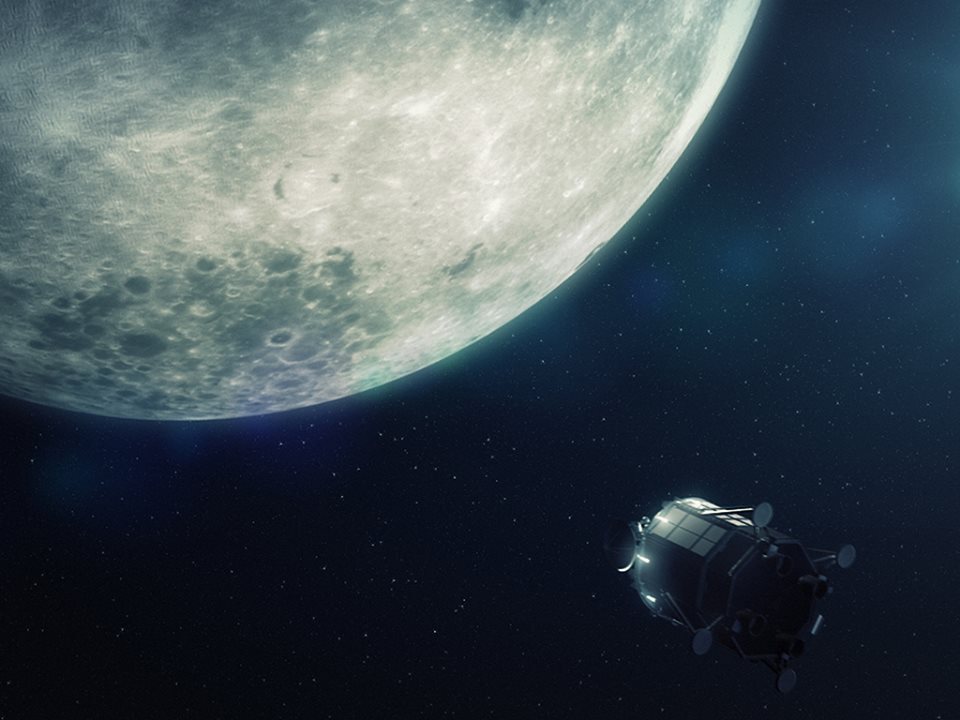Another private space exploration venture is under way with the British-led Lunar Mission One announcing plans to send an unmanned robotic landing module to the South Pole of the Moon. Initially funded by a Kickstarter campaign, the non-profit organization hopes to drill ten times deeper into the lunar surface than has ever previously been attempted and use the borehole to store a giant digital time capsule of human knowledge.
Under development for about eight years, the UK-based Lunar Mission One had its public launching this week at the the Royal Society's 12th Reinventing Space Conference in London. The effort was founded as Lunar Mission Ltd by former Royal Navy Engineering Officer David Iron, and is partnered with the University College of London and the Open University among others. Its goal is to develop and land a probe at the Lunar South Pole by 2024 as part of an effort to not only gather more knowledge about the Moon, but also to promote public interest in space exploration and develop new means of funding future missions without government support.
According to Lunar Mission, the South Pole was chosen because it has the advantages of regular sunlight during the lunar southern hemisphere summer, and it's where recent space probes have shown the possible presence of water ice in the shadows of craters. The idea is that the spacecraft will act as a platform for a wireline drill that will bore a 5 cm (1.9 in) hole at 15 cm/hr (5.9 in/hr) down at least 20 m (65 ft), which is 10 times deeper than anything previously attempted on the Moon. The organization says that it could even reach 100 m (328 ft) if conditions are right.

To add to this already a daunting objective, Lunar Mission points out that the drill, which will weigh only 10 kg (22 lb), will need to work without the cooling liquid or clay slurries used in terrestrial drills, and must be able to withstand to extremely cold lunar nights and the winters. As it drills, the top 10 m (32 ft) of the lunar soil is expected to be powdery, having been stirred and worn by asteroid and micro-meteor strikes for billions of years. The lower layers are expected to be made of pummeled and fused rock. Since the purpose is to take core samples, the drill will leave behind a stub tube to keep loose soil from falling back into the hole.
The hope is to retrieve and analyze rock samples that have been undisturbed for 4.5 billion years. If this is possible, the project's supporters say that it could determine the origin of the Moon with "one hundred percent certainty," study how the asteroid bombardments early in its history affected the Moon, and determine if the lunar South Pole is a suitable site for a manned base.
In addition to its geological work, Lunar Mission One also hopes to act as an educational venue by encouraging the participation of young people in the venture, and to leave behind on the Moon the most ambitious time capsule yet in the history of space exploration.

Where previous space missions have been content to send along plaques or phonograph records, Lunar Mission One's planned sequel to its drilling operation is for the empty hole to be filled with a copy of a "public archive" of millions of digital files that will chronicle the history of human civilization and life on Earth, including a species database. The promoters say that the public archive will be a peer reviewed international effort of unprecedented size, and once compiled, will be available to anyone back on Earth for free.
In a very 21st century manner, the initial funding for the project will come in the form of a Kickstarter campaign with the goal of raising £600,000 (US$955,000) by December 17. As premiums, the campaign is offering private "memory boxes" for pledges of £60 (US$95), in which they can place whatever private messages they wish for future lunar visitors. Once the project is fully up and running, these memory boxes will be for open sale to the public at a cost reflecting the amount of digital memory needed to record individual items. It will even be possible to send along DNA in the form of a strand of hair.
At the moment, the lunar lander is largely conjectural, based on mission objectives and design parameters. The craft will need to be carried by a medium-lift launch vehicle from Earth, be able to make mid-course corrections, and carry its payload safely in a controlled powered descent to the lunar surface within a landing area the size of a football stadium.

Once down, a robotic arm will deploy the drilling system and other instruments, collect the 15 cm (5.9 in) long core samples, analyze them, and insert the data base cylinders. All of this will need to be done on less than a kilowatt of power from the solar panels.
The Kickstarter money is intended to fund only the initial project management and planning phases. Later phases will be funded by the sale or raffling of memory boxes, and a global sales and marketing campaign. Midpoint revenues are projected at £3 billion (US$4.7 billion). The promoters hope that the funding efforts for Lunar Mission One could provide enough profit to seed future missions as an ongoing cycle.
The video below introduces Lunar Mission One.
Source: Lunar Mission One










